 Image search results - "toyooka" Image search results - "toyooka" |

When you arrive JR Toyooka Station, you will soon notice that the Oriental white stork ("kounotori" in Japanese) is the symbol of the city. Even the roof looks like a soaring bird.
|
|

Directional sign at JR Toyooka Station.
|
|

Vending machine with Oriental white stork design motif at JR Toyooka Station.
|
|

Oriental white stork decoration at JR Toyooka Station. To see real, living Oriental white storks, you have to visit the Hyogo Park of the Oriental White Stork Park.
|
|

From JR Toyooka Station, there are buses that go to Hyogo Park of the Oriental White Stork Park. However, they run only once or twice an hour. Bus schedule under the purple column.
|
|

The bus going to Hyogo Park of the Oriental White Stork Park is designed like a bag to promote Toyooka as a bag-producing city.
|
|
|

Love Toyooka's bag bus.
|
|

Hyogo Park of the Oriental White Stork has a few buildings amid large rice paddies and mountains.
|
|

Huge rice paddy within Hyogo Park of the Oriental White Stork.
|
|

Rice paddy has a high nesting platform. The nest still intact.
|
|

Spider web.
|
|

Kounotori can also mean "bird bringing happiness." Sculpture related to the bird of happiness. Makes people happy especially when the stork delivers your baby.
|
|

White stork mail box at Oriental White Stork Park in Toyooka, Hyogo.
|
|

Basic map of Hyogo Park of the Oriental White Stork. Only one building on the left is open to the public.
|
|

Gate to Hyogo Park of the Oriental White Stork. Open: 9:00 am–5:00 pm, closed Mondays (open if a national holiday and closed the next day instead), December 28th–January 4th.
|
|

The building in the middle is the University of Hyogo Graduate School of Regional Resource Management.
|
|

On the right is the park's administrative building.
|
|

On the left is the Toyooka Kounotori Bunkakan or Oriental White Stork Culture Center.
|
|

Inside the Oriental White Stork Culture Center. Walk through this building to the other side of the building to see the open cage.
|
|

Toyooka Oriental White Stork Culture Center's open cage for Oriental white storks. It includes paddies used for feeding. The cage is "open" because it only hasa fence and no roof.
|
|

Toyooka Oriental White Stork Culture Center's open cage for Oriental white storks. There are about nine storks in the open cage. Their wings have been clipped to they cannot fly.
|
|

So if you go to Hyogo Park of the Oriental White Stork, you can see real Oriental white storks.
|
|

About the Oriental white stork open cage.
|
|

Around 9:30 am to 10 am, they feed the storks. This is the best time to visit the park. And the best chances of seeing storks flying around.
|
|

They are throwing small dead fish into the paddies.
|
|

The storks are carnivores, feeding on fish, frogs, snakes, rabbits, mice, etc.
|
|

The Oriental white stork has black and white wings and a black bill.
|
|
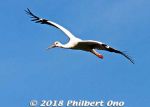
The Oriental white stork is a big, beautiful bird often mistaken as the Japanese crane. Wingspan is 2 meters.
|
|

Once found all over Japan, the Oriental white stork ("kounotori" in Japanese) became extinct in the wild in Japan in 1971 despite preservation efforts since 1955.
|
|

Toyooka was where the last living Oriental white stork in Japan died in 1986. Pesticides in rice paddies (where they feed) and other environmental problems caused their demise.
|
|

In 1985, six wild Oriental white stork chicks from the USSR (Khabarovsk) were acquired to be raised in Toyooka. From 1989, the birds from Russia started to breed successfully in captivity in Toyooka every year.
|
|

From 2005, the park started releasing Oriental white storks into the wild in Toyooka, which was a great celebration. The birds then started to breed and reproduce in the wild.They've been releasing only a few birds (fewer than 5) almost every year.
|
|

As of Oct. 2018, Japan has over 140 Oriental white storks in the wild. They are also successfully breeding in Tokushima, Shimane, and Kyoto Prefectures. It's still an endangered species, with only slightly over 2,000 of them in the Far East.
|
|
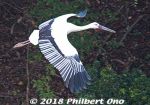
I didn't expect to see the storks flying around, so I was thrilled when a few of them flew overhead while I was in the park. They flew in during feeding time.
|
|
|
|
|
|
|
|
|
|
|
|

They make a loud clacking noise with their bills.
|
|
|
|
|
|
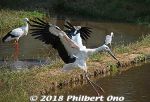
White stork landing in the paddy during feeding time.
|
|

Feeding time for the storks also attracts unwanted birds like black kites. They swoop in and steal a fish, then don't come back.
|
|

Grey herons also drop by, but they are always fighting each other.
|
|
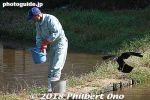
Crows also drop by.
|
|

Storks swallow the fish whole.
|
|
|
|
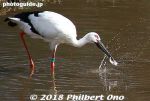
Oriental white stork eating a fish.
|
|

Landing on a nesting platform.
|
|
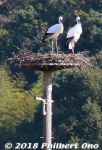
Two Oriental white storks on a nesting platform. Each nesting platform has a video camera monitoring it 24/7 especially during the egg-laying and hatching season in spring.The park is likely crowded during this time until the babies leave the nest in June/July.
|
|

Oriental white stork nests are large, about 2 meters diameter, made of tree branches and straw.
|
|

Back inside the Oriental White Stork Culture Center. On the left is the European white stork with a red bill, on the right is the Oriental white stork with a black bill. Very similar.
|
|

The hanafuda card with the "crane" is actually an Oriental white stork. It actually looks like a cross between the two birds...
|
|

Exhibits.
|
|
|
|
|
|
|
|
|
|
|

Screening room.
|
|

Aquariums with fish.
|
|

Even insects.
|
|

Part of the park is a large biotope used as a stork sanctuary and research facility. Only part of it is open to the public.
|
|
|

Nesting platform.
|
|

About the biotope.
|
|

Large biotope used as a stork sanctuary and research facility.
|
|

Park's website: http://www.stork.u-hyogo.ac.jp/en/
|
|

Gift shops in this building next to the parking lot.
|
|

Confection shaped like stork eggs.
|
|

Oriental White Stork manhole in Toyooka, Hyogo Prefecture.
|
|

Oriental White Stork manhole in Toyooka, Hyogo Prefecture.
|
|

Airline with a plane donning an Oriental White Stork motif.
|
|

The area near JR Toyooka Station is also nice for walking around. In front of the station is Aity, a shopping complex. Where I went for groceries and dinner.
|
|

The street in front of Toyooka Station is lined with shops too. Sun Stork Avenue.
|
|

Always a reminder of what this city is famous for. Oriental white stork tiles on the sidealk.
|
|

Kimono shop.
|
|

The sidewalk lined with shops have a roof so we're okay even on rainy days.
|
|
|

Toyooka City Hall
|
|

Toyooka City Hall
|
|

Vintage building housing a restaurant.
|
|

Tobacco shop selling cigarettes. This kind of shop will likely become obsolete in Japan.
|
|

Toyooka in Hyogo Prefecture is a major producer of bags. Thier local bus even has a bag design.
|
|

Toyooka's bag bus.
|
|

Walk until you reach Caban Street. "Caban" or "kaban" means "bag." Not shopping bag, but ladies' bags, briefcases, etc.カバンストリート
|
|

Caban Street is lined with several bag shops. カバンストリート
|
|

Toyobra bag shop on Caban Street.
|
|

Toyobra bag shop on Caban Street.
|
|

Caban Street in Toyooka, Hyogo. カバンストリート
|
|

Caban Street's most prominent bag shop is this one called Artisan Avenue. The front has a woven basket motif. Toyooka, Hyogo Prefecture.
|
|

How Toyooka became a bag-producing city.
|
|

Artisan Avenue sells high-end bags of all kinds made in Toyooka. These ones are similar to the ones that were first made in Toyooka.
|
|

There are many bag companies here, most are high-end bags costing tens of thousands of yen. Some of them supply materials to world-famous bag makers.
|
|

Nice bags at Artisan Avenue.
|
|

Insde Artisan Avenue.
|
|

Another bag shop on Caban Street.
|
|

Caban Street also had this place to repair or clean your bag.
|
|

Caban Street also had this place to repair or clean your bag.
|
|

On the left is a cloth bag vending machine.
|
|

On Caban Street, this drink vending machine designed like a bag. Toyooka, Hyogo.
|
|

Even the mail box on Caban Street is designed like a bag...Their official website: http://cabanst.com/
|
|

When visiting Toyooka, visiting Izushi is also highly recommended. Short bus ride from JR Toyooka Station to the Izushi bus stop here.
|
|

In Japanese, Izushi is written as 出石 which we may normally pronounce in other ways. So even the local bus makes its clear with hiranaga on how it's pronounced. Very unusual pronunciation.
|
|

The Izushi bus stop is conveniently located near Izushi Castle.
|
|

Way to Izushi Castle and Shinkoro Clock Tower.
|
|

Izushi's symbol is the Shinkoro Clock Tower. This area is also a National Important Traditional Townscape Preservation District (重要伝統的建造物群保存地区). 辰鼓楼
|
|

Shinkoro Clock Tower in Izushi, Toyooka, Hyogo Prefecture is one of Japan's oldest clock towers along with the Sapporo Clock Tower also built in 1881. 辰鼓楼
|
|

Shinkoro Clock Tower in Izushi, Toyooka, Hyogo Prefecture is one of Japan's oldest clock towers along with the Sapporo Clock Tower also built in 1881. 辰鼓楼
|
|

Shinkoro Clock Tower was first built in 1871 without any clock. 辰鼓楼
|
|

Shinkoro Clock Tower was orignally used to beat taiko drums from 7 am to 9 am to notify people that the castle lord arrived at the castle. A mechanical clock from the Netherlands was later donated by a local doctor to make it a clock tower in 1881. 辰鼓
|
|

About the Shinkoro Clock Tower. 辰鼓楼
|
|

Manhole with Shinkoro Clock Tower design in Izushi, Toyooka, Hyogo Prefecture.
|
|

Manhole with Shinkoro Clock Tower design in Izushi, Toyooka, Hyogo Prefecture.
|
|

Izushi Castle in Toyooka was built in the early 17th century. No original structures remain except for the stone walls and foundations. Reconstructed turrets and a small shrine are on the castle grounds. 出石城
|
|

Tojobashi Bridge to Izushi Castle's Tojomon Gate. 出石城 登城門・登城橋
|
|

Castle moat.
|
|

Izushi Castle is on a low hill. Only some steps to climb.
|
|

Some stone walls and foundations still remain.
|
|
|

Pulling out weeds from the stone wall.
|
|

Stone work on Izushi Castle.
|
|
|

Reconstructed West Corner Turret. 西隅櫓
|
|

Reconstructed West Corner Turret. 西隅櫓
|
|
|

Reconstructed West Corner Turret. 西隅櫓
|
|
|

Reconstructed West Corner Turret is not open to the public. 西隅櫓
|
|

Castle wall.
|
|

East Corner Turret.
|
|

East Corner Turret.
|
|

East Corner Turret.
|
|
|

Izushi Castle's Honmaru
|
|

Izushi Castle's Honmaru has a large stone foundation for the main tower,
|
|

Izushi Castle's Honmaru has a large stone foundation for the main tower,
|
|

Izushi Castle's Honmaru has a large stone foundation for the main tower,
|
|
|

Izushi Castle's West Corner Turret.
|
|
|
|
|
|

Entrance to the path of torii gates to Ariko-yama Inari Jinja Shrine atop Izushi Castle's main foundation. 有子山稲荷神社
|
|
|
|

Torii gates to Ariko-yama Inari Jinja Shrine atop Izushi Castle's main foundation. 有子山稲荷神社
|
|

There are over 30 torii gates to the shrine.
|
|

The torii gate path goes along the east side of Izushi Castle.
|
|
|
|
|
|
|

Ferns and trees make the place solemn.
|
|

Ariko-yama Inari Jinja Shrine atop Izushi Castle's main foundation. 有子山稲荷神社
|
|

Ariko-yama Inari Jinja Shrine atop Izushi Castle's main foundation. 有子山稲荷神社
|
|

Ariko-yama Inari Jinja Shrine atop Izushi Castle's main foundation. 有子山稲荷神社
|
|

Atop Izushi Castle's main foundation also gives great views of Izushi.
|
|

Views of Izushi.
|
|

Views of Izushi from Izushi Castle.
|
|

Views of Izushi from Izushi Castle.
|
|

Shinkoro Clock Tower as seen from Izushi Castle.
|
|

Japanese pine tree.
|
|

Going back down through the torii gates.
|
|
|
|
|
|

On Nov. 3, Izushi holds the Oshiro Matsuri to reenact the daimyo procession.
|
|
|

Izushi Town Hall
|
|

Gift shop in Izushi.
|
|

Gift shop in Izushi.
|
|

Samurai residence.
|
|
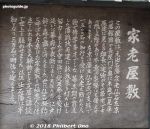
About the Samurai residence.
|
|

Izushi soba is famous for having cold soba served on five small plates. Dip the noodles in the broth while adding different garnishes like grated yam, onions, and raw egg. 出石そば
|
|

Lots of soba restaurants in Izushi. This lunch cost ¥870. You can also order more plates of noodles. The history of Izushi soba goes way back to the early 18th century when the local lord brought it from Nagano (Shinano soba). 出石そば
|
|

These five plates are not much for the average stomach. It was a good snack. 出石そば
|
|

Izushi also has Eirakukan (永楽館), the Kansai Region's oldest kabuki theater built in 1901. It closed in 1964 due to the spread of television and other diversions.Years later, the theater was renovated and reopened in 2008. The theater puts on performances occasionally.
|
|

Eirakukan (永楽館), the Kansai Region's oldest kabuki theater built in 1901. Toward the left was the theater's front entrance that is not used anymore because of the road right in front. They now use a side entrance.
|
|

The theater's original front entrance that is not used anymore because of the road right in front. They now use a side entrance.
|
|

The theater is in Izushi's National Important Traditional Townscape Preservation District (重要伝統的建造物群保存地区).
|
|

Theater entrance on the side. The theater is a short walk from the Izushi bus stop and Izushi Castle.
|
|

You have to take off your shoes.
|
|

Theater lobby.
|
|

Theater lobby.
|
|

Inside Eirakukan. You can freely tour inside the theater. Very impressive and rare glimpse of a Meiji Period theater. That's the hanamichi on the left. You can walk on it too.
|
|
|

The hanamichi on the left. You can walk on it too.
|
|

The hanamichi on the left. You can walk on it too and feel like a kabuki actor...
|
|
|
|

Eirakukan Theater in Izushi, Toyooka, Hyogo.
|
|
|

Stage as seen from the back row.
|
|

Side seats.
|
|
|
|
|
|
|
|

Advertising posters on the walls.
|
|

Very retro.
|
|

The revolving stage (mawari-butai). Above the stage in the back are dressing rooms for the performers. Normally hidden by a curtain.
|
|

Eirakukan's rotating kabuki stage.
|
|

Rotating kabuki stage.
|
|

View from the stage.
|
|
|
|
|
|

Stage curtains.
|
|

Booth for instrument players.
|
|

Inside a booth for instrument players.
|
|

Backstage has the dressing rooms for actors. Normally hidden by a curtain.
|
|

Dressing room.
|
|

Dressing room.
|
|

Dressing room.
|
|

Dressing room.
|
|

Bathtub for actors.
|
|
|
|

Go downstairs to the basement too.
|
|

You can also go underneath the stage and see the revolving stage. It's rotated by hand. Wow neat, how often can you see something like this?
|
|

They turn the rotating stage by hand.
|
|

Stage wheels on a rail.
|
|
|

Basement passage to the other end of the theater.
|
|

Other stairway.
|
|

Toyooka also has Kinosaki Onsen (城崎温泉), a hot spring only 10 min. away by train from Toyooka Station. It's one of the best onsen I've ever visited in Japan.
|
|

Kinosaki Onsen's main highlight are its seven public hot spring baths (sotoyu 外湯). Some of them look palatial, and they are all distinctly different, the baths, decor, etc.Kinosaki Onsen has a long history of 1,300 years. A favorite hot spring for centuries.
|
|

Scenic train ride from Toyooka to Kinosaki Onsen.
|
|

JR Kinosaki Onsen Station on the JR San'in Line.
|
|

Inside JR Kinosaki Onsen Station.
|
|

Next to the station is this collection of donated geta wooden clogs from local inns.
|
|

In front of JR Kinosaki Onsen Station.
|
|

Drinkabke hot spring water in front of JR Kinosaki Onsen Station.
|
|

Next to JR Kinosaki Onsen Station is one of the seven celebrated public baths. This one is named Sato-no-Yu Onsen. Chinese-style building that includes a cold bath. Open 1:00 pm–9:00 pm, closed Mon. さとの湯
|
|

Sato-no-Yu Onsen さとの湯
|
|

Free foot bath at Sato-no-Yu Onsen さとの湯. Great to relax your feet before getting on the train.
|
|

Entrance to Sato-no-Yu Onsen. I didn't go in this one though. さとの湯
|
|

Walking further along the main drag, some pictureque buildings. Kinosaki Onsen is a compact hot spring town, most things are within walking distance.
|
|
|

The main drag of Kinosaki Onsen goes along the Otani River (Otanigawa) lined with pretty willow trees. 大谿川
|
|

Even the convenience stores were designed to blend in with the local townscape.
|
|

The second public bath I came across is Jizo-yu.
|
|

Jizo-yu public bath in Kinosaki Onsen, Toyooka, Hyogo Prefecture. Open 7:00 am–11:00 pm, closed Fri. 地蔵湯
|
|

Jizo statue at Jizo-yu public bath.
|
|
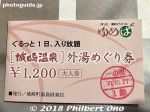
Guests who stay at a ryokan in Kinosaki Onsen can visit all seven public baths for free. But daytrippers like me have to pay admission for each one, costing ¥600 or ¥700. However, they have a public bath day pass for only ¥1,200 (外湯めぐり券). Use it to enter all seven. Great deal! Definitely one of the best bargains in Japan!
|
|
|
|